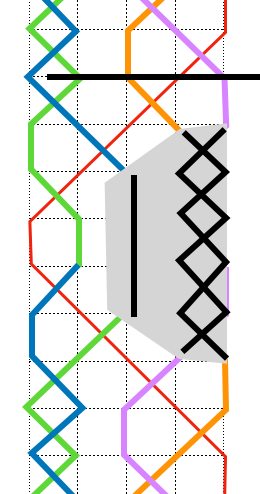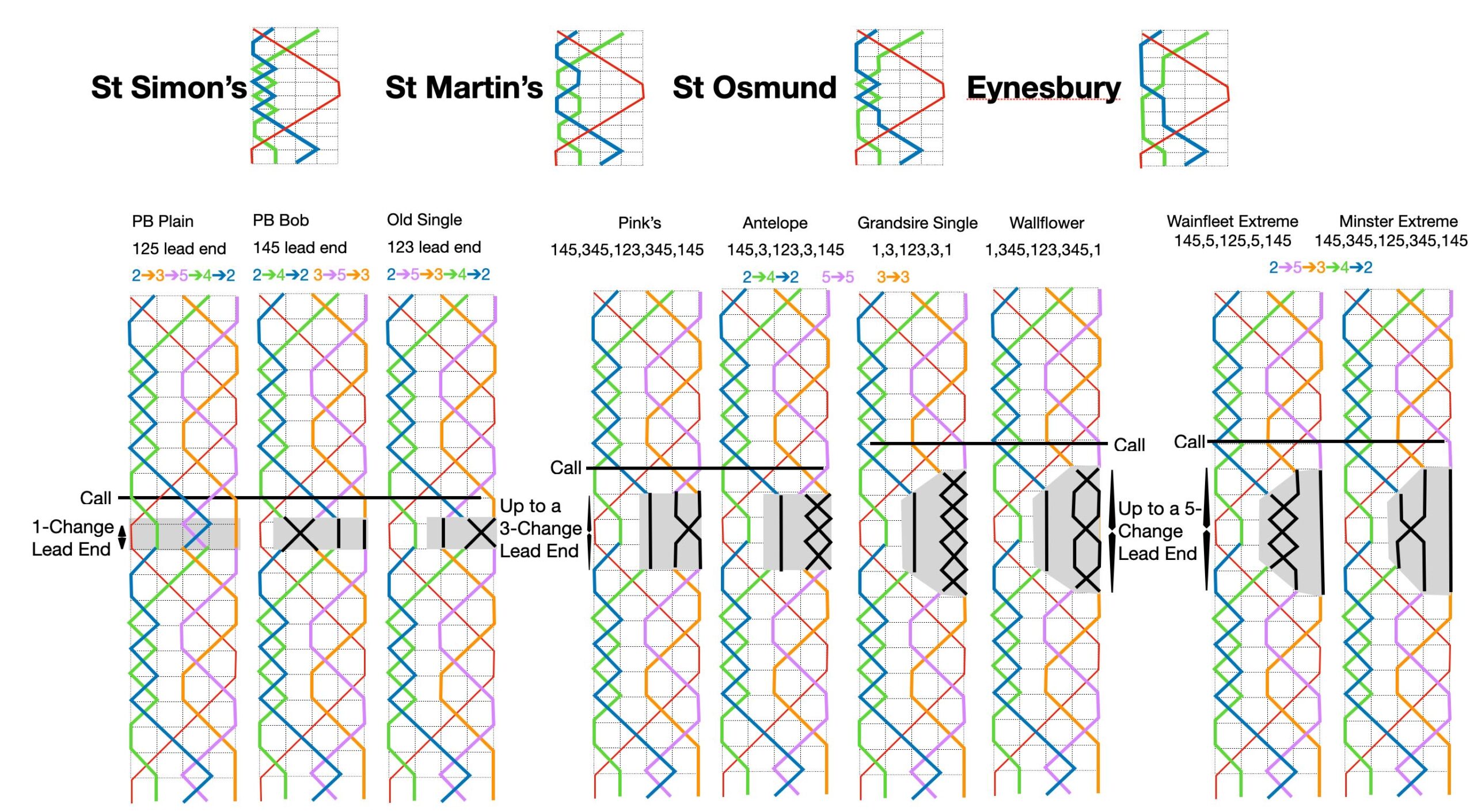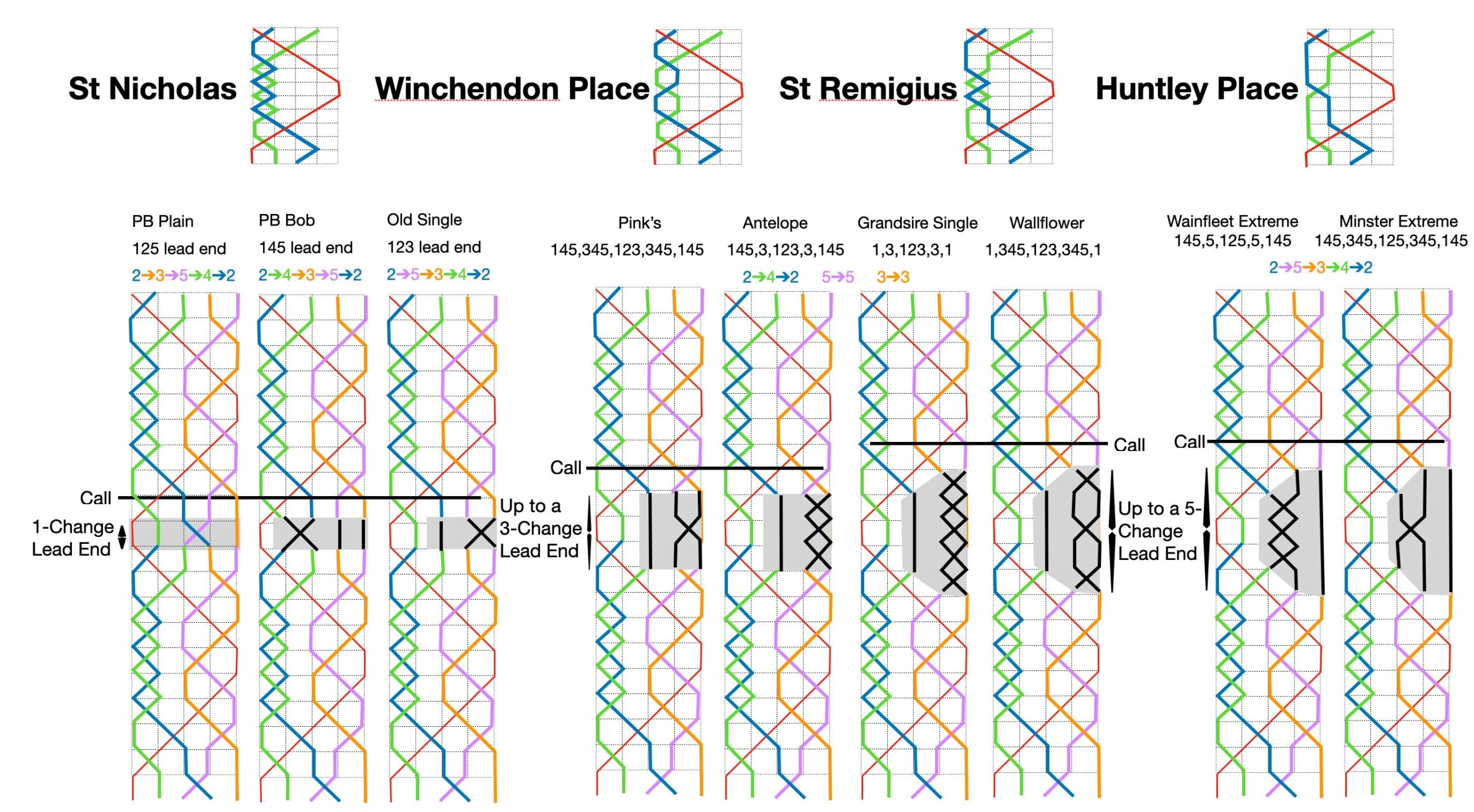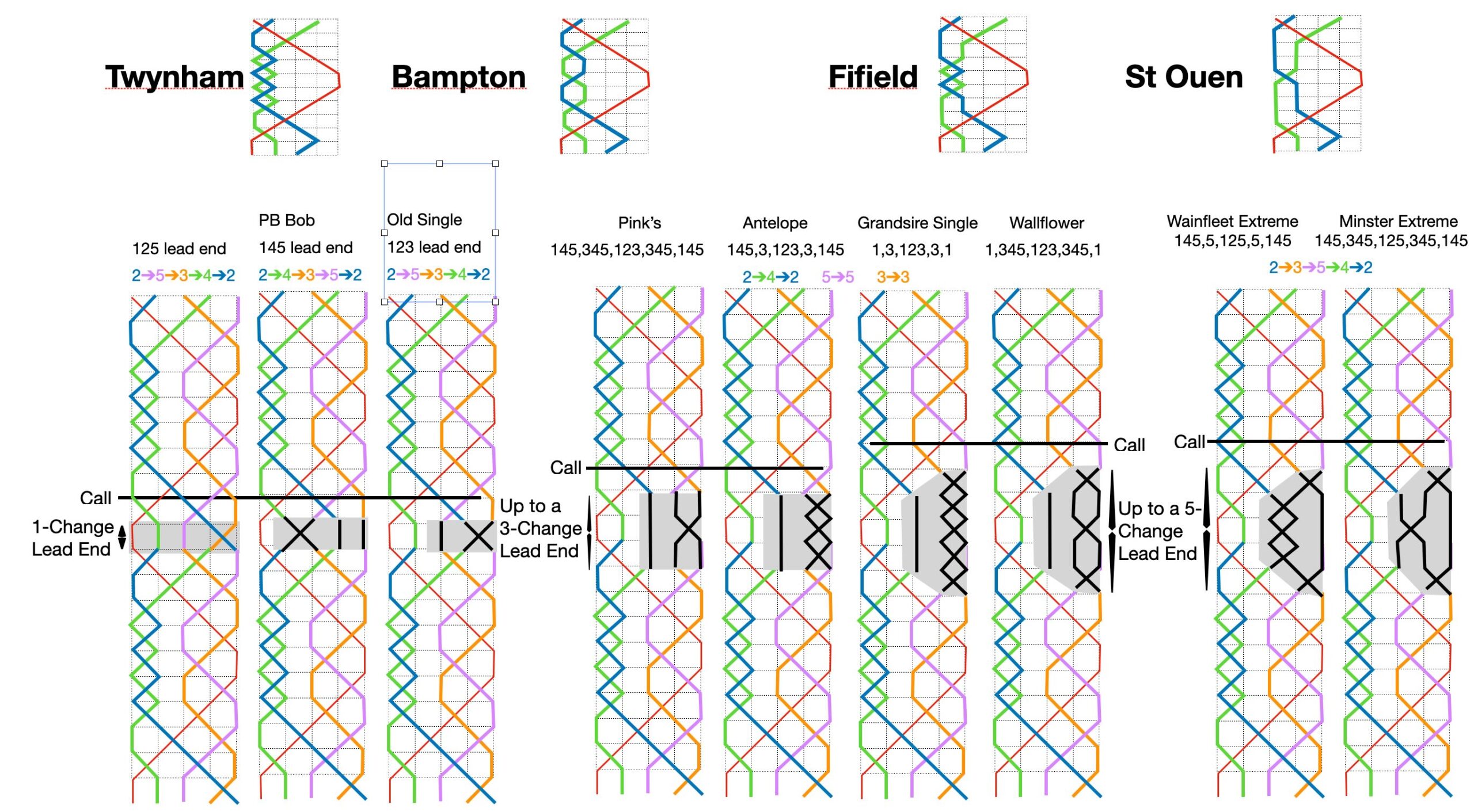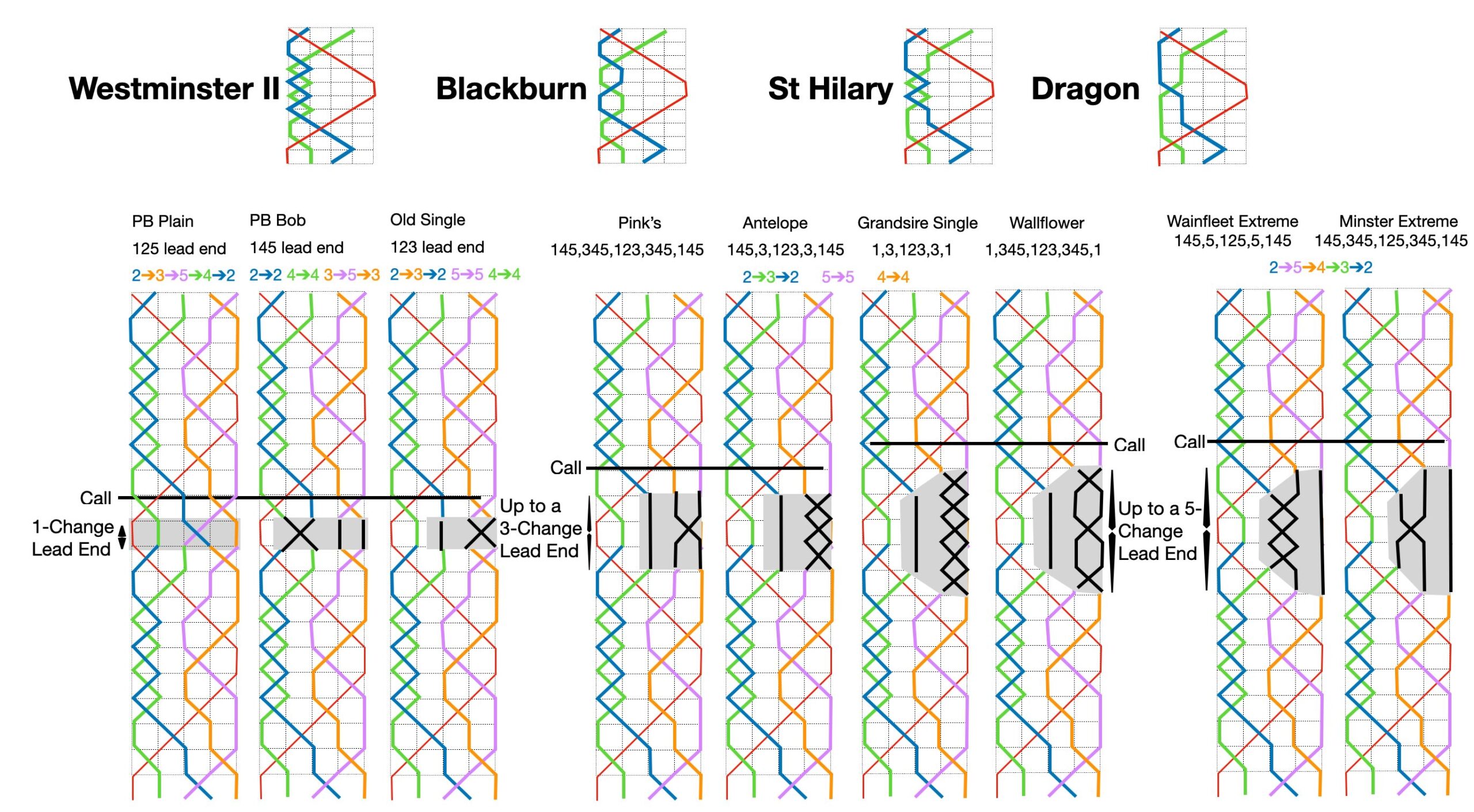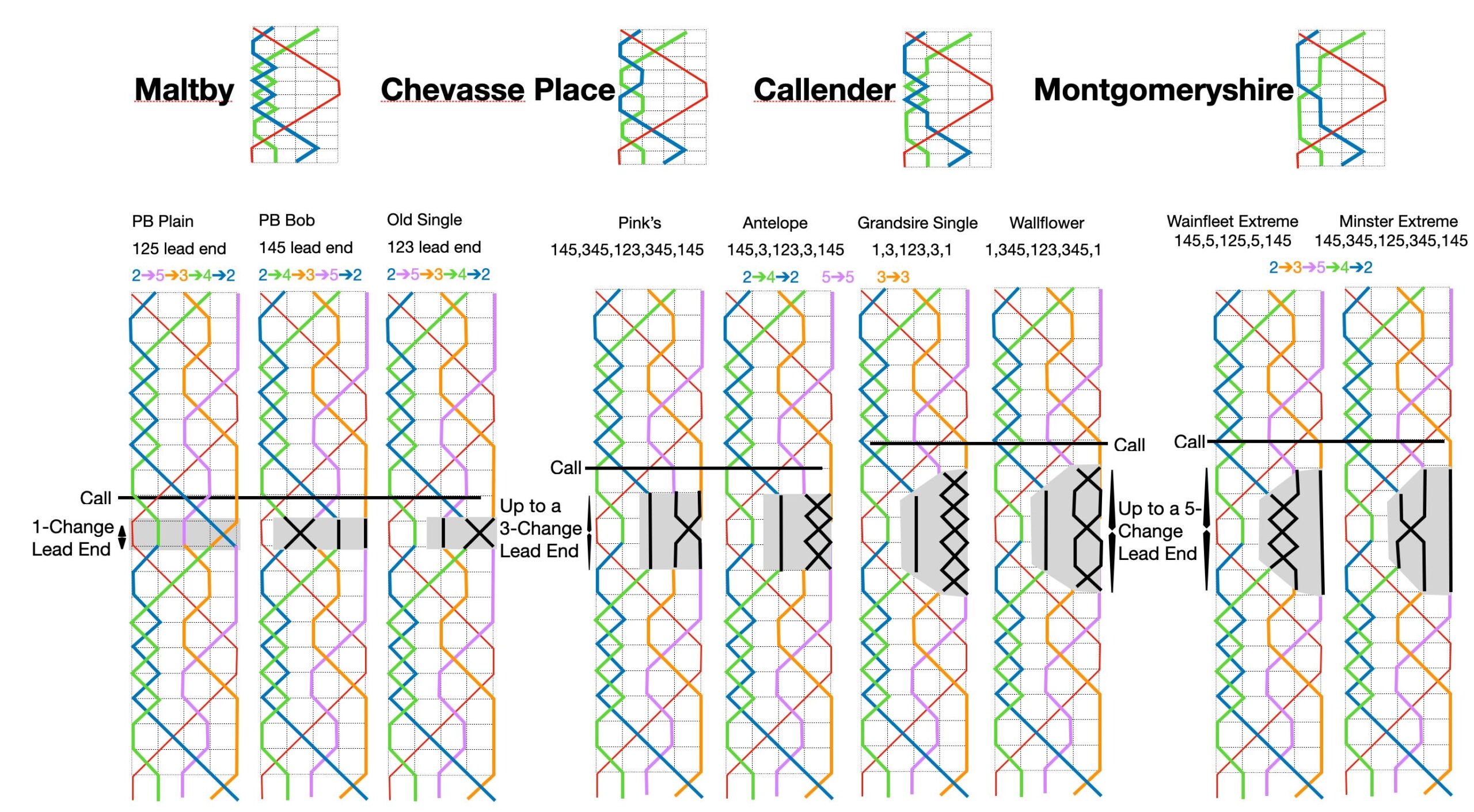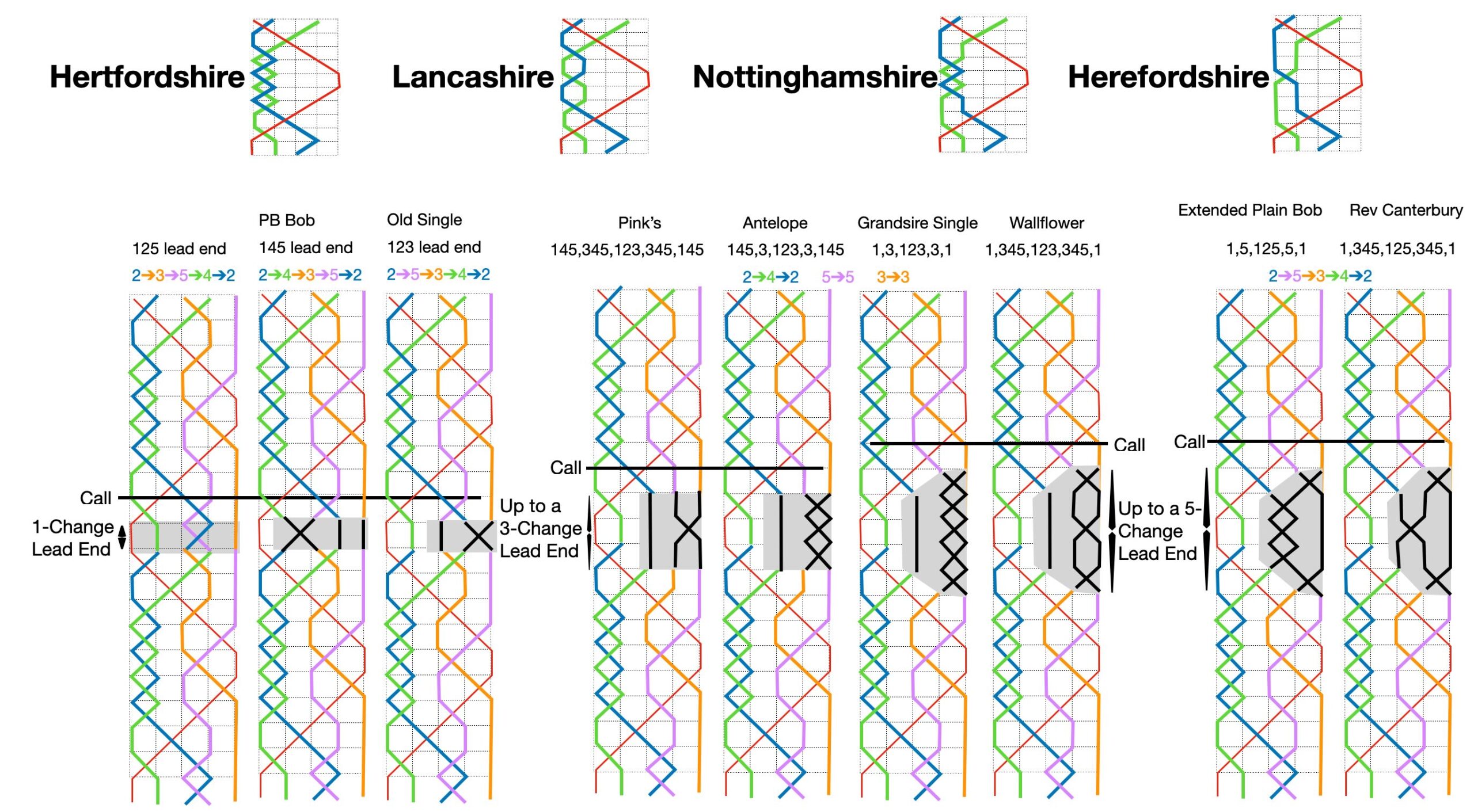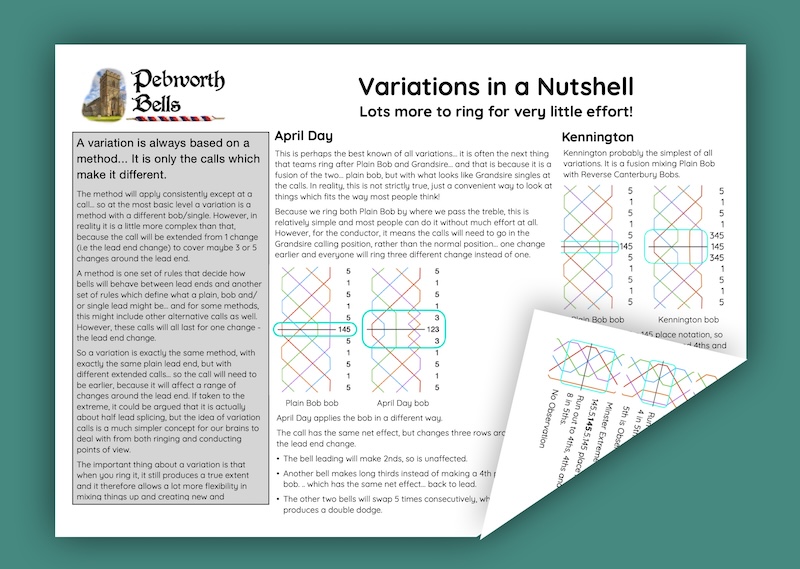Method Variations
A method variation is exactly what it says… it is a way to create new and different variants of a method.
Variations can theoretically be applied to any stage of method ringing, but in reality it is only commonly used for and is not recognised by the Central Council for anything other than doubles.
Variations provide a simple way to extend your doubles repertoire without having to do much work or learning… It is all about mixing things up without the complexity of splicing.
Print our Crib Sheet
We understand that it is not always possible to look at an online page when inside a tower that has three foot thick stone walls and some folks just like to have something tangible….
So to help, we have produced a crib sheet which prints as a two sided A4 sheet. (If your printer can print both sides, remember to set it to short edge binding so the second page prints the right way up!)
The crib sheet contains most of the information you see on this web page, but formatted for A4 paper!
Variations in a Nutshell...
A variation is always based on a standard method... It is only the calls which make it different.
The method will apply consistently except at a call… so at the most basic level a variation is a method with a different bob/single. However, in reality it is a little more complex than that, because the call will be extended from 1 change (i.e the lead end change) to cover maybe 3 or 5 changes around the lead end.
A method is one set of rules that decide how bells will behave between lead ends and another set of rules which define what a plain, bob and/or single lead might be… and for some methods, this might include other alternative calls as well. However, these calls will all last for one change – the lead end change.
So a variation is exactly the same method, with exactly the same plain lead end, but with different extended calls… so the call will need to be earlier, because it will affect a range of changes around the lead end. If taken to the extreme, it could be argued that it is actually about half lead splicing, but the idea of variations is a much simpler concept for our brains to deal with from both ringing and conducting points of view.
The important thing about a variation is that when you ring it, it still produces a true extent and it therefore allows a lot more flexibility in mixing things up and creating new and interesting possibilities for ringers and conductors alike.
Kennington doubles
- Kennington is probably the simplest variation. If you can ring both Plain Bob Doubles and Reverse Canterbury Doubles, then you will also be able to ring Kennington… because it is just a synthesis of the two. Plain Bob doubles, with Reverse Canterbury Bobs.
- Because we ring Plain Bob by where we pass the treble, the fact that the Reverse Canterbury bobs work differently from the standard Bobs is of little consequence, we just do the next piece of work according to the treble. As a result, most people can ring Kennington without much effort at all.
However, for the conductor, it means the calls will need to go in one change earlier, rather than the normal position… this is because everyone will ring three different change instead of one in order to include the Reverse Canterbury places.
Let’s look in more detail…
The Structure of Plain Bob
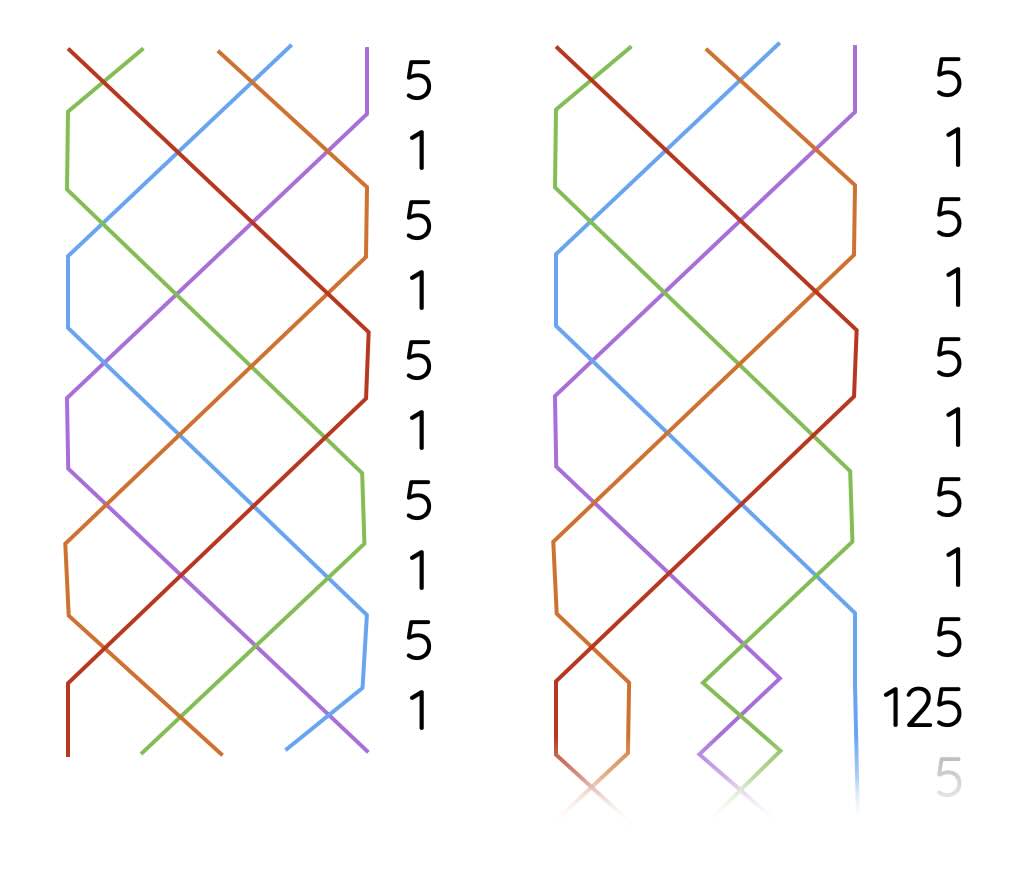
If we compare Plain Hunt and Plain Bob, we will find they are identical except for the very last row…. The Plain Bob lead end.
- Plain Hunt is the simplest of all principles where pairs of bells are swapped alternately until the bells return to their original starting point.
- In Plain Hunt doubles, it is two pairs in each row that are swapped…. so a ‘double swap’ and hence the name ‘doubles’.
Place notation is a useful way to annotate this process and you can see this beside each diagram. Place Notation takes the lazy option and assumes all bells swap unless stated otherwise…
- In the first row, 1-2 and 3-4 swap and 5 remains static.
- In the second row, 2-3 and 4-5 swap, so 1 remains static.
Thus the place notation for plain hunt is 5.1 repeat… and it will come back to rounds after 10 changes, but leaving the other 110 possible changes un-rung!
- If we look at Plain Bob doubles, it too uses the plain hunt principle – but with one exception…
- the point where the treble (in red) is leading.
- At this point a bell makes 2nds which upsets the pattern…
- this means only one pair can swap.
In place notation, this is written as 125 and produces three consecutive 3-4 swaps (called a dodge) and a ‘5’ in three consecutive rows (which creates 4 blows behind). The result of this is that all bells except the treble move to a new starting position…
- 2➔4, 4➔5, 5➔3, 3➔2.
- This extends the plain hunt principle to 40 changes.
Plain and Bob Lead ends...
When we add a bob to Plain Bob, we use exactly the same idea… it is only the lead end change which differs…
- A different bell now makes 4ths instead of 2nds.
- This can be written as 145.
The result is a much simpler lead end…
- The front three bells continue to plain hunt
- The 4th and 5th now deviate
- the 5th still makes 4 blows.
- On its own, this call only swaps 2 bells and can only extend plain hunt to 20 changes, but if combined with plain leads, it can extend the method to all 120 changes.
- Three bobs added at 40 change intervals will do this.
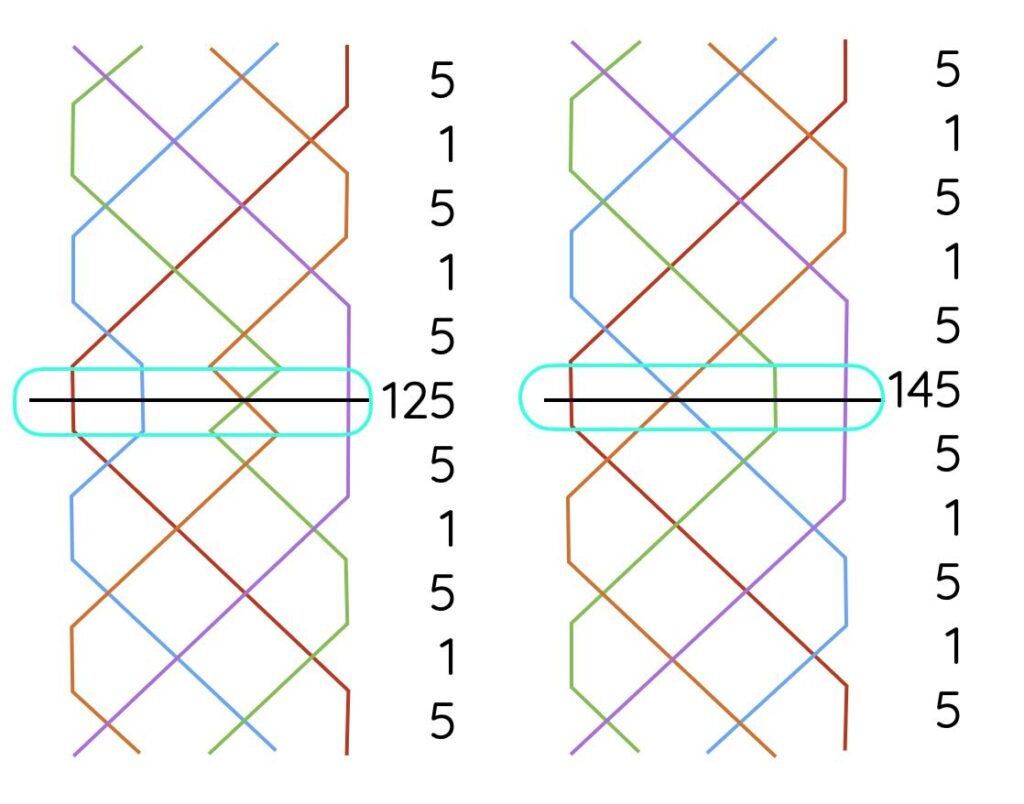
Reverse Canterbury Bobs
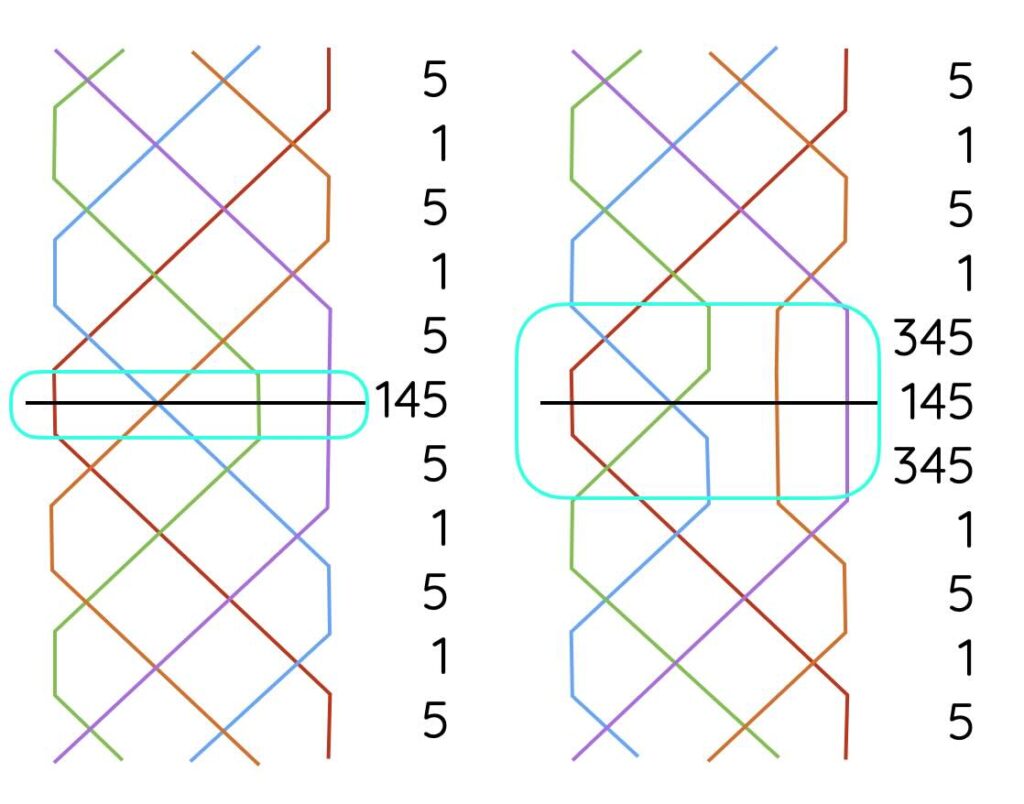
In Kennington, we take the idea of a bob and apply it in a different way. The call has the same net effect, but will actually changes three rows to include the rows just before and just after the lead end change.
The bob itself is still a 145 place notation, so bells still plain hunt at the front and 4th and 5th are made at the back.
However, places in 3rds and 4ths are made in the change before and after the lead end as per Reverse Canterbury.
The result is….
- a bell makes 3rds before hunting in to lead.
- another bell hunts out rom lead to make thirds, before return to lead.
- A bell makes long fourths (fourths, bob, fourths)
- The last bell makes long fifths as normal.
Because the bob now last for three changes, the call needs to be place one blow earlier.
April Day doubles
This is perhaps the best known of all variations and it is often the next thing that teams ring after Plain Bob and Grandsire.
That is because it is a fusion of the two… plain bob, but with what looks like Grandsire singles at the calls.
In reality, this is not strictly true, as none of the other Grandsire baggage comes with it… It is just a convenient way to look at things which fits the way most people think! A more logical way to consider it would be as a plain lead of St Augustines, except very few people know that method!
Once again, ringing plain bob by where we pass the treble, makes doing this relatively simple… we just wait to see where when and where the treble passes us and react accordingly.
However, for the conductor, it means the calls will need to go one change earlier, in the Grandsire calling position, rather than the normal position… and everyone will ring three different changes instead of one.
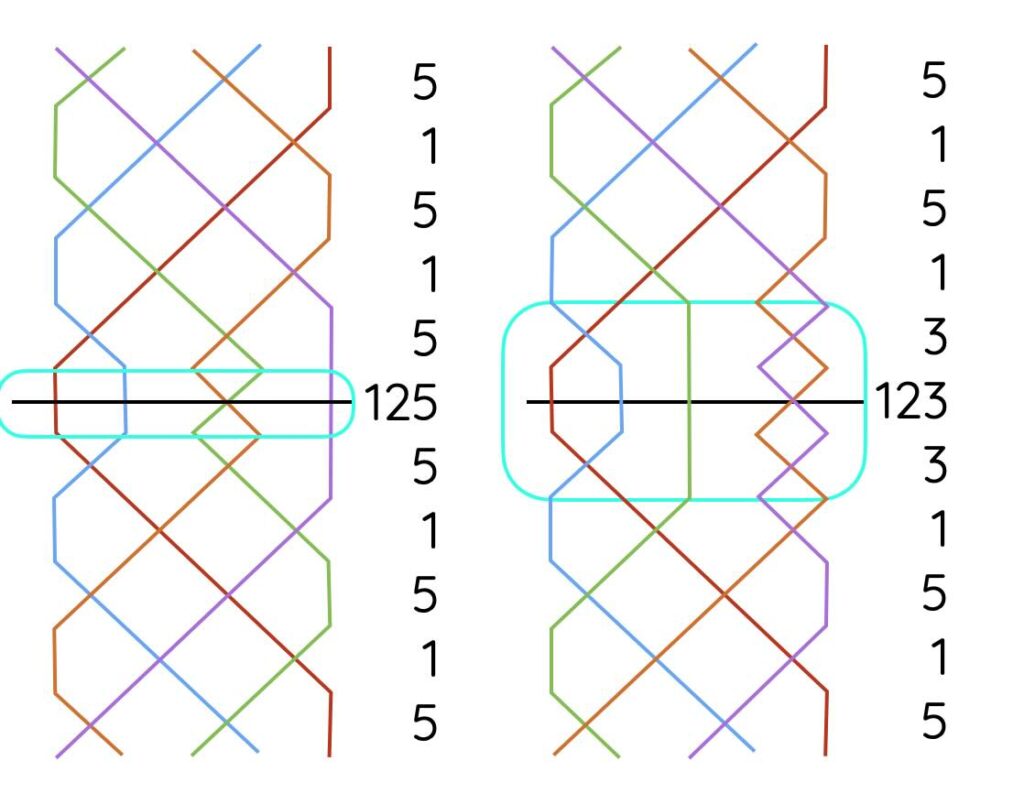
With April Day, we can see that the Bob place notation is 123 so different from the usual 145. It also includes a 3 notation instead of the usual 5 before and after the lead end. This creates a very different looking call.
- Like a plain lead, a bell still makes 2nds. This bell is therefore unaffected by the call and can be considered as the observation bell.
- All three changed rows contain a 3… so a bell makes ling 3rds.
- 4 and 5 swap in all three rows as well as having swapped in rows before and after as well. These five swaps create a a double dodge.
- The net effect of the bob is similar to a normal bob… switch three bells around and three bobs separated by 40 changes will therefore extract all 120 changes.
10 for the price of 1
Having explored 2 variations, we now know three different ways of extracting 120 changes from Plain Bob Doubles.
In practice, there are many more alternatives too, so we have listed some of them below. Some alter five changes so require bobs to be called two blows early. Most are based on other common doubles methods or their calls.
For the really adventurous, there are also lots of asymmetric calls…. but that is really another story and only for those who are really keen!

Call
- Wallflower Bob (All Saints Plain)
- Antelope Single
- Pink’s Single
- Grandsire Extreme
- Wainflect Extreme
- Minster Extreme
- Old Single
Name
- Sleighford
- Litchurch
- May Day
- Hudibras
- Jacksdale
- Great Barton
- Old Bob
We have now listed 9 variations to go with one method.
If you choose 10 variations along with the method itself, it would be possible to ring an entire quarter peal which used a different variants for each extent.
In practice, it is possible to add the calls to any method, so it would be quite possible to ring an entire quarter peal based on almost any other single method.
Moving to the next level...
St Simon's
- Variations can easily be applied to methods like St Simon’s.
- Because it has a plain bob lead end, we can use exactly the same variation calls.
- …and if we can do it for St Simon’s, we can also do it with St Martin’s, St Osmond’s and Eynesbury which have slightly different front works.
- This creates 9 more variations for each…
Call
- Plain Bob Bob
- Reverse Canterbury Bob
- Grandsire Single (All Saints Bob)
- Wallflower Bob (All Saints Plain)
- Antelope Single
- Pink’s Single
- Grandsire Extreme
- Wainflect Extreme
- Minster Extreme
- Old Single
Name
- St Simon’s
- St Alban
- Eynesham
- Elford
- St Jude
- St Ignatius
- Somerville
- Haughley
- Pakenham
- Old Bob
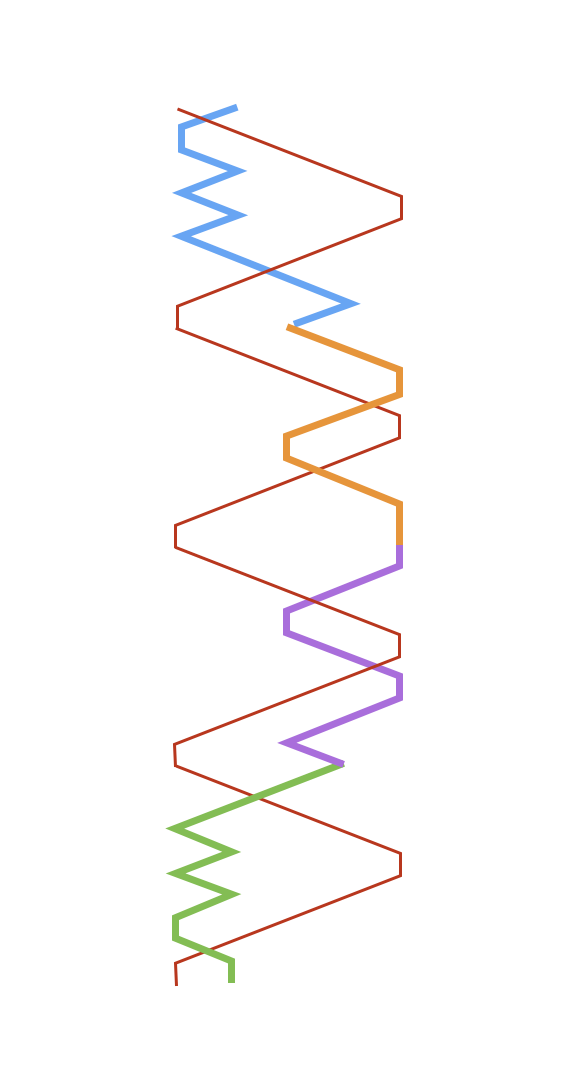
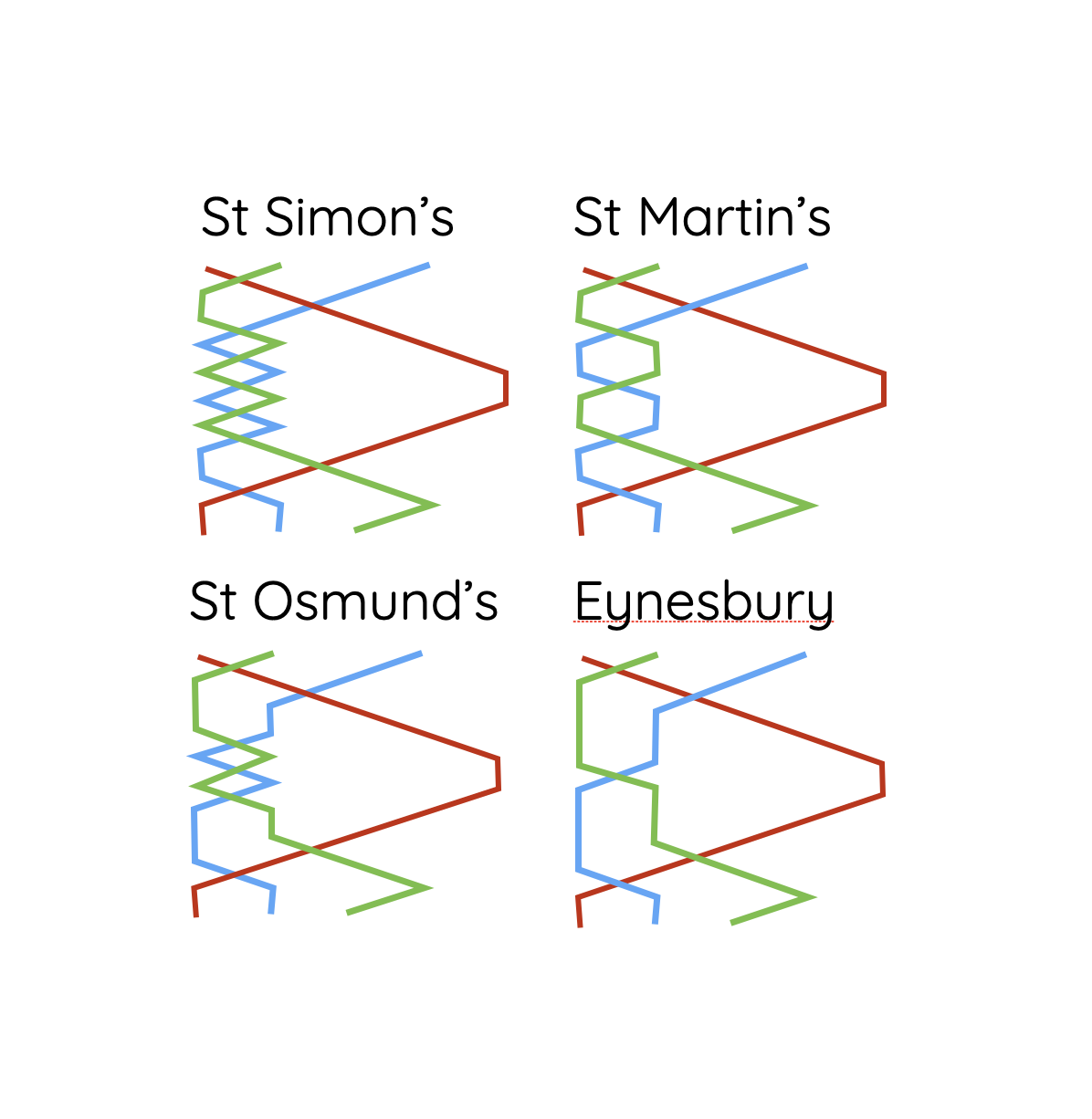
St Martin's
Call
- Plain Bob Bob
- Reverse Canterbury Bob
- Grandsire Single (All Saints Bob)
- Wallflower Bob (All Saints Plain)
- Antelope Single
- Pink’s Single
- Grandsire Extreme
- Wainflect Extreme
- Minster Extreme
- Old Single
Name
- St Martin’s’
- St Paul
- St Leonard
- Austrey
- St Laurence
- Churchill
- Magdalen
- Zizania
- Thurston
- St Peter
St Osmund
Call
- Plain Bob Bob
- Reverse Canterbury Bob
- Grandsire Single (All Saints Bob)
- Wallflower Bob (All Saints Plain)
- Antelope Single
- Pink’s Single
- Grandsire Extreme
- Wainflect Extreme
- Minster Extreme
- Old Single
Name
- St Osmund
- St Ambrose
- St Ninian
- St Felix
- St Austell
- Amersham
- St Werburgh
- Old Newton
- Greatt Livermore
- St Patrick
Eynesbury
Call
- Plain Bob Bob
- Reverse Canterbury Bob
- Grandsire Single (All Saints Bob)
- Wallflower Bob (All Saints Plain)
- Antelope Single
- Pink’s Single
- Grandsire Extreme
- Wainflect Extreme
- Minster Extreme
- Old Single
Name
- Eynesbury
- St John the Evangelist
- St John the Baptist
- St Wenceslas
- St Stephen
- St John the Divine
- St Deborah
- Fornham All Saints
- Ingham
- Candlemas
Splicing
If you wish to really maximise the number of methods you ring, you could always try splicing the four front works in a single 120.
- A simple option (see example) is for the conductor to ring one method for the back work and one of the other methods with each of the other bells.
- Ring St Simon’s at the back (3rds and 5th place bells)
- Ring St Martin with bell 4
- Ring St Osmund with bell 3
- Ring Eynesbury with bell 2
- A good band will probably help and may not even need any splice calls for this… they will just do it!
- This option means it would be very easy to ring 40+ methods in a single quarter peal.
- For simplicities sake, the conductor will normally only call the base method… i.e Go St Simon’s and then name of the call at each of the bobs… e.g. Plain Bob bob. This way, no one will need to learn all the method names which would be very confusing… especially with ‘St John’… which appears in three related variations!
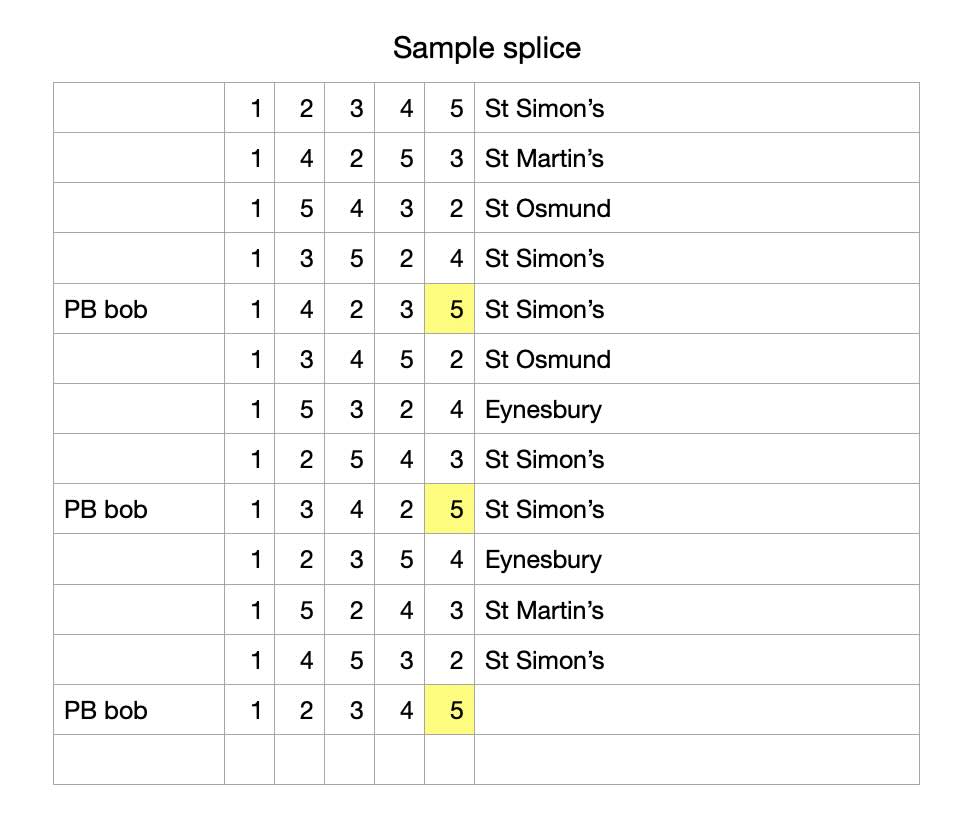
Lots of Names!
Of course it would be very easy to then extend the idea further by using different back works… (e.g. Reverse Canterbury/St Nicholas, Twynham/Plain Hunt, Shipway/Westminster II and several others which will each provide up to 40 more method/variations. That would create a peal of 160+ methods which sounds unbelievably impressive, especially as it only uses 4 front works and 4 back works, all of which are fairly common!
If you want details of common variations in a tabular form, the Cambridge Ringing link below provides a selection of well laid out pages showing many possibilities.
The CCCBR page is less helpful yet mind blowing as it comprehensively lists absolutely everything, including 5823 named variations and over 200 different calls…. but unless you know what you are looking for, realistically, it is far less useful!
Variation Navigation
Below, you will a set of 6 diagrams which will help you to learn the different variations and calls.
Because the variations insert 3 or 5 change lead ends, working out the new place bell after a call can be quite tricky… especially in the methods which do not hunt after the lead end… so we have produce diagrams which show a colour coded lead with each of the variation lead ends. This is followed by another identical colour coded lead of the same method…
All you need to do is follow the line through and see which colour it turns.
If you want to call variations… do note the calling positions. The 3 change variations (iPink’s or Antelope) need to be called one blow early (i.e. at hand stroke when the treble is in 3rds). The five change variations (e.g Wallflower or Grandsire single) need to be called two blows earlier (i.e. at the backstroke when the treble is in 4th place).
- Example
- 5th place bell is the pink line.
- You will double dodge down.
- At the end of the double dodge, you are still following the pink line.
- You are therefore repeating 5th place bell!
You are 2nd place bell…
- This is the Blue line.
- After making long 3rds, you are then on the green line.
- The green line is 4th place bell.
